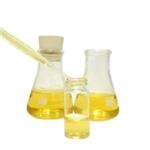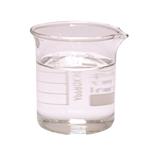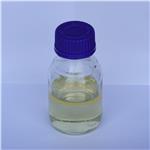Uses
m-Cresol is an important organic intermediate (building block) to synthetize substituted aryl products.
Chemical Properties
Cresol is a mixture of the three isomeric cresols, o-, m-, and p-cresol. Cresols are slightly soluble in water. m-Isomer: Colorless or yellow liquid with characteristic odor.
Chemical Properties
colourless to light yellow liquid
Chemical Properties
m-Cresol has a dry, tarry, medicinal–leathery odor. m-Cresol and p-cresol very often occur together and are difficult
to separate.
Occurrence
Reported found in beer, coffee, egg, grape, Oriental tobacco, roasted barley, rum, sherry and whiskey.
Uses
m-Cresol is employed in the preparation of synthetic resins like phenol-formaldehyde resins, disinfectants, and photographic developers. It is used as industrial solvent for dissolving polymers such as polyaniline. It acts as a precursor to vitamin E and antiseptic amylmetacresol. It is used as insuline preservatives.
Uses
Antiseptic; antimicrobial preservative.
Uses
m-Cresol is used as a disinfectant and solvent.
Lysol
TM disinfectant is a 50% (v/v) mixed-cresol isomer in
a soap emulsion formed on mixing with water. The isomer
m-cresol is an oily liquid with low volatility. Besides disinfection
at solutions of 1–5%, the cresols are used in
degreasing compounds, paintbrush cleaners, and additives in
lubricating oils. Cresols were once widely used for
disinfection of poultry houses, but this use has been discontinued
because they cause respiratory problems and abdominal
edema in young chicks. m-Cresol has been used in
synthetic resins, explosives, petroleum, photographic, paint,
and agricultural industries.
Preparation
One process involving butylation and separation and followed by dealkylation produces m-cresol and ditertiary butyl
p-cresol. From m, p-cresol (which is the main product of the recovery process) pure m-cresol can be obtained by extraction.
Production Methods
The cresols (cresylic acids) are methyl phenols and generally
appear as a mixture of isomers. m-Cresol is prepared
from m-toluic acid or obtained from coal tar or petroleum
(352, 355, 356). Crude cresol is obtained by distilling
“gray phenic acid” at a temperature of ~180–201°C. The
m-cresol may be separated from the crude or purified mixture
by repeated fractional distillation in vacuo. It can also be
prepared synthetically by diazotization of the specific toluidine
or by fusion of the corresponding toluenesulfonic acid
with sodium hydroxide.
Definition
ChEBI: M-cresol is a cresol with the methyl substituent at position 3. It is a minor urinary metabolite of toluene. It has a role as a human xenobiotic metabolite.
Aroma threshold values
Aroma characteristics at 1.0%: phenolic, spicy eugenol-like, medicinal, smoky powdery with a leatherlike
note.
Taste threshold values
Taste characteristics at 2 ppm: phenolic, smoky, balsamic, medicinal and spicy eugenol-like
General Description
Colorless liquid with a sweet tarry odor. Sinks and mixes slowly with water.
Air & Water Reactions
Water soluble.
Reactivity Profile
m-Cresol is sensitive to air, light and heat. m-Cresol is also hygroscopic. m-Cresol can react vigorously with strong oxidizers and strong bases. m-Cresol reacts violently with nitric acid, oleum, chlorosulfonic acid, metals and strong acids. If the water content is below approximately 0.3% and the temperature above 248° F, the corrosion of aluminum and its alloys may occur violently. m-Cresol will attack some forms of plastics, coatings and rubber.
Hazard
Questionable carcinogen.
Health Hazard
INHALATION: Mucosal irritation and systemic poisoning EYES: Intense irritation and pain, swelling of conjunctiva, and corneal damage may occur. SKIN: Intense burning, loss of feeling, wrinkling, white discoloration, and softening. Gangrene may occur. INGESTION: Burning sensation in mouth and esophagus. Vomiting may result. Acute exposure by all routes may cause muscular weakness, gastroenteric disturbances, severe depression, collapse. Effects are primarily on CNS and edema of lungs. Injury of spleen and pancreas may occur.
Flammability and Explosibility
Not classified
Contact allergens
Metacresol is contained as a preservative in almost all human insulin. It has been reported as a cause of allergic reaction due to injected insulin.
Safety Profile
v Poison by ingestion,
intravenous, intraperitoneal, and
subcutaneous routes. Moderately toxic by
skin contact. Severe eye and skin irritant. An
experimental teratogen. Human mutation
data reported. Questionable carcinogen with
experimental neoplastigenic data.
Flammable when exposed to heat or flame.
Moderately explosive in the form of vapor
when exposed to heat or flame. See also
other cresol entries and PHENOL.
Potential Exposure
Cresol is used as a disinfectant and fumigant; as an ore flotation agent, and as an intermediate in the manufacture of chemicals, dyes, plastics, and antioxidants. A mixture of isomers is generally used; the concentrations of the components are determined by the source of the cresol.
Carcinogenicity
m-Cresol has induced a few papillomas
but no carcinomas in tumor studies.
Shipping
UN2076 Cresols, liquid, Hazard class: 6.1; Labels: 6.1-Poisonous materials, 8-Corrosive material. UN3455 Cresols, solid, Hazard class: 6.1; Labels: 6.1- Poisonous materials, 8-Corrosive material.
Purification Methods
Separation of the m-and p-cresols requires chemical methods, such as conversion to their sulfonates [Brüchner Anal Chem 75 289 1928]. An equal volume of H2SO4 is added to m-cresol, stirred with a glass rod until solution is complete. Heat for 3hours at 103-105o. Dilute carefully with 1-1.5 volumes of water, heat to boiling point and steam distil until all unsulfonated cresol has been removed. Cool and extract the residue with ether. Evaporate the solution until the boiling point reaches 134o and steam distil off the m-cresol. Another purification method involves distillation, fractional crystallisation from the melt, then redistillation. Free from p-cresol by solution in glacial acetic acid and bromination by about half of an equivalent amount of bromine in glacial acetic acid. The acetic acid is distilled off, then fractional distillation of the residue under vacuum gives bromocresols from which 4-bromo-m-cresol is obtained by crystallisation from hexane. Addition of the bromocresol in glacial acetic acid slowly to a reaction mixture of HI and red phosphorus or (more smoothly) of HI and hypophosphorus acid, in glacial acetic acid, at reflux, removes the bromine. After an hour, the solution is distilled at atmospheric pressure until layers are formed. Then it is cooled and diluted with water. The cresol is extracted with ether, washed with water, NaHCO3 solution and again with water, dried with a little CaCl2 and distilled [Baltzly et al. J Am Chem Soc 77 2522 1955]. The 3,5-dinitrobenzoate (prepared with 3,5-dinitrobenzoyl chloride in dry pyridine, and recrystallised from EtOH or aqueous Me2CO) has m 165o. [Beilstein 6 IV 2035.]
Incompatibilities
Vapors may form explosive mixture with air. Incompatible with strong acids; oxidizers, alkalies, aliphatic amines; amides, chlorosulfonic acid; oleum. Decomposes on heating, producing strong acids and bases, causing fire and explosion hazard. Liquid attacks some plastics and rubber. Attacks many metals.
Toxics Screening Level
The initial threshold screening level (ITSL) for Cresol has been derived (100 μg/m3 based on an 8-hour averaging time).
Waste Disposal
Wastewaters may be subjected to biological treatment. Concentrations may be further reduced by ozone treatment. High concentration wastes may be destroyed in special waste incinerators.





